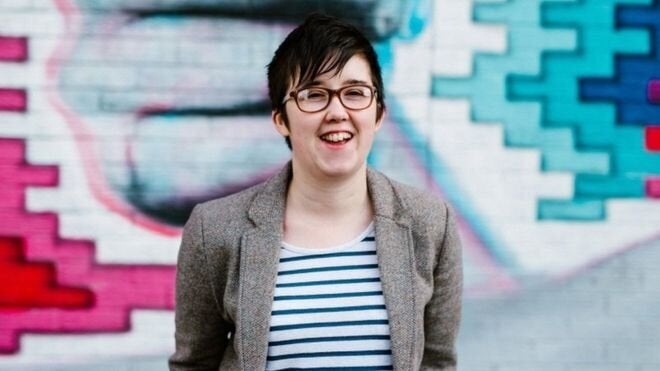A mural of murdered journalist Lyra McKee has been painted in Belfast city centre, alongside quotes from a powerful letter she wrote to her 14-year-old self.
The journalist and author was killed by indiscriminate fire as she observed clashes between police and New IRA dissidents on the Creggan estate in Londonderry on April 18.
The image, which is already attracting visitors on Monday, was created by Dublin artist Emma Blake.
Blake and 21 other artists blanketed most of Kent Street in new artwork over the bank holiday weekend as part of the annual Hit the North street art festival.
The letter from which the quotes were taken spoke of her struggles as a gay teenager in Northern Ireland. It has gained worldwide prominence since her death.
It contained the message “It won’t always be like this. It’s going to get better” – words that have assumed added resonance since her murder by the violent extremists.
The location of the mural is also significant, as it faces an existing artwork that provided a striking backdrop for a photograph of McKee that was widely circulated in days after she was killed.

Meanwhile, on the housing estate where McKee was shot, IRA graffiti has been painted over by the community.
Leona O’Neill shared a video of a fence in Creggan, Derry and said: “What once read ‘IRA undefeated army’ now reads ‘our differences make us stronger’ among other inspirational messages and the ‘informers will be executed’ message has been erased.”
Adam Turkington, the organiser of the Hit the North festival in Belfast, said Blake had been moved by McKee’s death and wanted to pay tribute.
He highlighted the prominent role art has played in the response to the shooting, noting the protest in Derry that saw friends of McKee place red hand prints on an office building used by dissident republicans and the painting over of IRA murals close to the murder scene.
“Street art is always dialogue,” he told the Press Association. “Writing on a wall is always political, whether you realise it or not.
“I think what’s been really interesting is how you’ve seen that the aftermath of Lyra’s death has played out in art on walls – whether it’s the bloody hand prints on the office walls or whether it’s people painting over the IRA murals in Derry. That’s activism.
“Street art has its roots in activism and in anti-establishment-ism, but also in finding ways to communicate with each other about things that really are hard to talk about.
“It’s about aesthetic, it’s about place-making. And especially in the context of Northern Ireland, where we have these very divisive murals, street art for me in this context is all about building a shared space and finding a place that people can co-exist.
“It’s a very natural thing in a way that Lyra has been represented in this way at the festival and long may it continue.”
